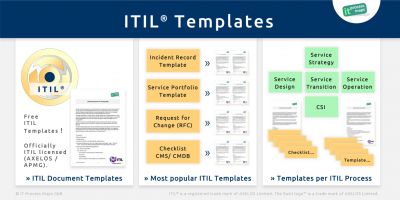ITIL Implementation - Process Design


| Step 8: Designing the ITIL Processes in Detail |
The 'Process design' step is about specifying in detail which activities need to be performed within each ITIL process.
Objectives
- Detailed definition of the individual activities within the ITIL processes ("ITIL process flows")
- Definition of guidelines/ checklists to support process execution
- Detailed definition of the process outputs
Description
Typically, the process owners will be responsible for this task. All relevant parties should be involved, especially members of staff who will execute the processes, to ensure that their experiences and knowledge is taken into account when designing the processes.

The process designs are usually documented in the form of flowchart diagrams. These should provide a clear idea of the required activities and their sequential order, without going into unnecessary detail. The diagrams will also specify the roles responsible for executing the activities.
The ITIL® Process Map supports this task with a complete set of flowcharts which can be adapted to the specific needs of particular organizations (see fig. 1: ITIL process flows).
To keep the process diagrams readable and focused, additional information to support the process execution should be attached to the flowchart diagrams in the form of linked checklists and document templates. An example would be a document containing detailed instructions for the registration and routing of incidents or service requests in 1st level support.
Prerequisites
- Structure of the Service Management processes to be introduced
- Process overviews (process breakdown)
- Interfaces of the ITIL processes to be introduced
- Measures (KPIs) for the ITIL processes to be introduced
Results/ Deliverables
- Detailed process descriptions in the form of flowchart diagrams and activity chains
- Possibly: Additional guidelines / checklists, instructions, etc.
- Definitions of the process outputs
Success factors
- Process descriptions should give a clear idea of the required activities and their sequential order, but too many details should be avoided. Too much detail usually means that these documents are soon out of date, as they are too bulky to be an effective tool for the Process Owners.
- It is recommended to confine further details into linked documents (e. g. guidelines and definitions of process outputs).
- It is decisive for a successful process implementation to include all the relevant parties in this phase of the project, in order to make use of their wide range of experiences from daily business, and to ensure that the redesigned processes will be accepted and adhered to.
Relevant Views of the ITIL Process Map
Being well prepared is essential at this point in order to avoid the risk of producing a large number of uncorrelated and oversized documents.

This is why our method of "ITIL Implementation Using ITIL Process Templates" takes great care to set up a framework of process structure and interfaces during the initial project steps. Due to the prior definition of the project interfaces, it is already established upon which inputs a process may build, and which results it must deliver for successive processes.
With this information clearly specified it becomes much easier to define a process flow in a simple, straightforward way.
The ITIL Process Map makes detailed process flows available for all ITIL processes (see fig. 1: ITIL process flows). These models fulfill the current requirements of ITIL.
Modifications will often be necessary to allow for special circumstances or preferences; these alterations are of course permitted, as long as the ITIL guiding ideas are followed.
Learn how to adapt the pre-configured ITIL best practice templates to the requirements of your organization:
Watch the video: "Using the ITIL Process Map" (10:02 min.)
As an addition to the detailed ITIL process flows, checklists/ document templates (see fig. 2: ITIL templates) are available within the ITIL Process Map, describing procedures or process outputs in detail where necessary.
We make samples of our ITIL document templates and checklists available for you in this IT Process Wiki:
→ "The most sought-after ITIL templates".
Resources
- [1] Detailed ITIL templates and checklists for defining ITIL process outputs and inputs
- [2] More on ITIL implementation with process templates
- [3] FAQ: ITIL reference processes; IT Process Maps.
- [4] Structure and contents of an ITIL process model: Video: Introduction - ITIL Process Map; IT Process Maps.
- [5] Business Process Model and Notation (BPMN) version 2.0.2 - Specification, as of January 2014: omg.org/spec/BPMN/ and omg.org/spec/BPMN/2.0.2/PDF.
Following project activity
→ ITIL Implementation - Step 9: Selection and Implementation of Application Systems
Notes
By: Andrea Kempter ![]() , IT Process Maps.
, IT Process Maps.
Objectives › Description › Prerequisites › Results/ Deliverables › Success Factors







